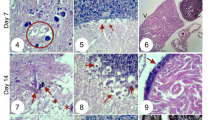Abstract
The planktivorous northern anchovy is a prominent vector of the phycotoxin domoic acid (DA) to organisms at higher trophic levels, including fish-eating seabirds and mammals. Although there are abundant data reporting DA-induced excitotoxic symptoms in higher vertebrates, to date there has been no reported evidence of neurotoxic effects in lower vertebrate vectors such as fish. To explain this apparent lack of toxicity, it has been suggested that DA may not reach the brain in anchovies and/or that fish are not as sensitive neurologically to DA. In the present study, intracoelomic (IC) injection of DA, at doses ranging from 1 to 14 μg DA g−1 total fish weight, resulted in severe neurotoxic symptoms such as spinning, disorientation, inability to school, and mortality, indicating that anchovies are neurologically susceptible and that DA crosses the blood–brain barrier in fish. An ED50 of 3.2 μg DA g−1 total body weight was determined via IC injection of DA in 83 anchovies. Comparable intraperitoneal injection studies with mice, rats, and monkeys report similar DA-induced neurotoxic symptoms at doses near 3.2 μg DA g−1, suggesting a similar neurologic sensitivity and mechanism of toxicity between anchovies and mammals. DA tissue distribution measurements from freshly collected field-exposed anchovies and orally gavaged anchovies indicate that DA uptake from the gastrointestinal tract does occur. Levels as high as 1,175 μg DA g−1 were measured in anchovy viscera, while muscle and brain tissue DA levels were 3 orders of magnitude lower, indicating low but measurable DA uptake. Further evidence is needed to confirm that uptake is sufficient during field events to induce symptoms in anchovies. Our work provides the first reported evidence of neurotoxic symptoms in fish and suggests that anchovies may be affected by DA during toxic diatom blooms. If sufficient uptake occurs, DA-induced neurotoxic symptoms and mortality may make fish easier prey targets, thereby selecting for the highest toxin levels transferred, as well as providing a possible pathway for the transfer of DA to benthic communities.
Similar content being viewed by others
Author information
Authors and Affiliations
Additional information
Received: 19 May 2000 / Accepted: 29 November 2000
Rights and permissions
About this article
Cite this article
Lefebvre, K., Dovel, S. & Silver, M. Tissue distribution and neurotoxic effects of domoic acid in a prominent vector species, the northern anchovy Engraulis mordax. Marine Biology 138, 693–700 (2001). https://doi.org/10.1007/s002270000509
Issue Date:
DOI: https://doi.org/10.1007/s002270000509




